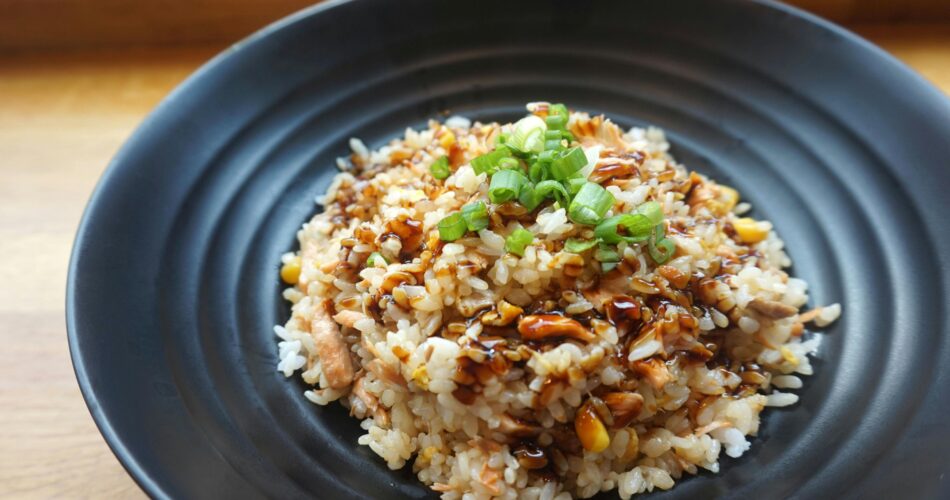Vegetable Fried Rice: A Delicious and Versatile Dish
Vegetable fried rice is a classic dish enjoyed around the world. It’s a fantastic way to use leftover rice, incorporate a variety of vegetables, and create a quick, satisfying, and healthy meal. This article will guide you through everything you need to know about making perfect vegetable fried rice at home, from selecting the right ingredients to mastering the cooking techniques.
Understanding the Fundamentals of Fried Rice
The foundation of any great fried rice is, of course, the rice itself. While freshly cooked rice might seem like a good idea, it actually contains too much moisture, leading to sticky and clumpy fried rice. The best fried rice is made with day-old rice that has been allowed to dry out slightly. This allows the grains to separate and crisp up nicely in the wok or pan.
Choosing the Right Rice
Long-grain rice, such as jasmine or basmati, is generally preferred for fried rice because it tends to be less sticky than short-grain varieties. However, medium-grain rice can also work well, especially if you are careful not to overcook it. Experiment with different types of rice to find your personal favorite.
The Importance of a Hot Wok (or Pan)
Another crucial element for successful fried rice is a very hot wok or large skillet. The high heat is what allows the rice to quickly stir-fry without steaming. A wok is ideal because its curved shape allows for even heat distribution and makes it easy to toss the ingredients. However, a large, heavy-bottomed skillet can also work well. Make sure your pan is thoroughly heated before adding any ingredients.
Essential Ingredients for Flavor
Beyond the rice and vegetables, several key ingredients contribute to the distinctive flavor of vegetable fried rice. Soy sauce is the most common flavoring agent, providing a salty and umami-rich base. Oyster sauce (optional) adds a deeper, more complex savory flavor. Sesame oil lends a nutty aroma and enhances the overall taste. A touch of ginger and garlic adds a pungent kick, while white pepper provides a subtle warmth. Experiment with different combinations of these ingredients to create your own signature flavor profile.
Selecting and Preparing Your Vegetables
The beauty of vegetable fried rice lies in its versatility. You can use almost any vegetable you have on hand, making it a great way to reduce food waste. However, some vegetables work particularly well in fried rice due to their texture and flavor.
Popular Vegetable Choices
Common choices include diced carrots, peas, corn, bell peppers, onions, and green onions. These vegetables add color, sweetness, and crunch to the dish. Mushrooms, broccoli florets, and bean sprouts are also excellent additions. For a more Asian-inspired flavor, consider adding bok choy, snow peas, or water chestnuts.
Preparing Vegetables for Stir-Frying
Proper preparation is key to ensuring that your vegetables cook evenly and retain their texture. Cut the vegetables into small, uniform pieces so they cook quickly and consistently. Harder vegetables, such as carrots and broccoli, may need to be blanched briefly before stir-frying to soften them slightly. Softer vegetables, such as peas and corn, can be added directly to the wok or pan.
Tips for Retaining Vegetable Texture
To prevent your vegetables from becoming mushy, avoid overcrowding the pan. Stir-fry the vegetables in batches if necessary to ensure they cook quickly and evenly. Cook the vegetables until they are tender-crisp, meaning they are cooked through but still retain a slight bite. This will add a pleasant textural contrast to the fried rice.
Step-by-Step Guide to Making Vegetable Fried Rice
Now that you understand the fundamentals and have your ingredients prepared, let’s walk through the process of making vegetable fried rice. This recipe assumes you are using day-old cooked rice and a wok or large skillet.
Ingredients
- 2 cups cooked and cooled rice (preferably day-old)
- 1 tablespoon vegetable oil
- 1 teaspoon sesame oil
- 1 clove garlic, minced
- 1/2 inch ginger, minced
- 1/2 cup diced carrots
- 1/2 cup frozen peas
- 1/2 cup corn
- 1/4 cup diced onion
- 2 tablespoons soy sauce (or to taste)
- 1 tablespoon oyster sauce (optional)
- 1/4 teaspoon white pepper
- 2 green onions, chopped
Instructions
1. Prepare the Wok: Heat the vegetable oil and sesame oil in a wok or large skillet over high heat. Make sure the pan is very hot before adding any ingredients.
2. Sauté Aromatics: Add the minced garlic and ginger to the hot oil and stir-fry for about 30 seconds, or until fragrant. Be careful not to burn the garlic.
3. Stir-Fry Vegetables: Add the diced carrots, peas, corn, and onion to the wok and stir-fry for 2-3 minutes, or until the vegetables are tender-crisp. If using other vegetables that require longer cooking times, add them earlier in the process.
4. Add Rice: Push the vegetables to one side of the wok and add the cooked rice to the empty space. Break up any clumps of rice with a spatula. Stir-fry the rice for 2-3 minutes, or until it is heated through.
5. Combine Ingredients: Mix the rice with the vegetables, ensuring that all ingredients are evenly distributed.
6. Add Seasonings: Pour the soy sauce and oyster sauce (if using) over the rice and vegetables. Sprinkle with white pepper. Stir-fry for another 1-2 minutes, or until the rice is evenly coated with the sauce and heated through.
7. Garnish and Serve: Garnish with chopped green onions and serve immediately.
Tips for Perfect Fried Rice
- Don’t Overcrowd the Pan: If you are making a large batch of fried rice, it’s best to cook it in batches to avoid overcrowding the pan. Overcrowding can lower the temperature of the pan and cause the rice to steam instead of fry.
- Use High Heat: Maintain a high heat throughout the cooking process to ensure that the rice and vegetables cook quickly and evenly.
- Stir Constantly: Stir the ingredients frequently to prevent them from sticking to the pan and to ensure that they cook evenly.
- Adjust Seasonings to Taste: Taste the fried rice and adjust the seasonings as needed. You may want to add more soy sauce for a saltier flavor or more white pepper for a spicier kick.
Variations and Customizations
One of the great things about vegetable fried rice is its adaptability. You can easily customize the recipe to suit your preferences and dietary needs. Here are a few ideas for variations and customizations.
Adding Protein
While this article focuses on vegetable fried rice, you can easily add protein to make it a more substantial meal. Scrambled eggs are a classic addition, and they can be added at the end of the cooking process. Other protein options include tofu, chicken, shrimp, or pork. If adding meat, cook it separately before adding it to the fried rice.
Vegetarian and Vegan Options
Vegetable fried rice is naturally vegetarian, but you can easily make it vegan by omitting the oyster sauce. Use a vegetarian oyster sauce substitute or simply add a bit more soy sauce and a dash of sugar to achieve a similar flavor.
Spice It Up
If you like a bit of heat, consider adding chili flakes, sriracha, or a dash of chili oil to your vegetable fried rice. You can also add chopped fresh chilies for a more intense flavor.
Experiment with Different Vegetables
Don’t be afraid to experiment with different vegetables. Try adding roasted vegetables, such as sweet potatoes or butternut squash, for a sweeter flavor. You can also add leafy greens, such as spinach or kale, for added nutrients.
Sweet and Savory Combinations
Consider adding a touch of sweetness to your vegetable fried rice by including ingredients like pineapple chunks or raisins. These additions can create a delightful sweet and savory flavor profile.
Serving and Storing Vegetable Fried Rice
Vegetable fried rice is best served hot, immediately after cooking. It can be enjoyed as a main course or as a side dish.
Serving Suggestions
Serve vegetable fried rice on its own or alongside other Asian-inspired dishes, such as spring rolls, dumplings, or stir-fried noodles. You can also top it with a fried egg or a sprinkle of sesame seeds for added flavor and texture.
Storing Leftovers
Leftover vegetable fried rice can be stored in an airtight container in the refrigerator for up to 3-4 days. Reheat it in a microwave or skillet until heated through. When reheating fried rice, make sure it reaches a safe internal temperature to prevent foodborne illness.
Freezing Fried Rice
While not ideal, fried rice can be frozen for longer storage. However, the texture of the rice may change slightly after freezing and thawing. To freeze fried rice, allow it to cool completely and then transfer it to an airtight container or freezer bag. Freeze for up to 2-3 months. Thaw in the refrigerator overnight before reheating.
Frequently Asked Questions (FAQ)
Why is my fried rice sticky?
Sticky fried rice is usually caused by using freshly cooked rice or rice that has too much moisture. Using day-old rice and ensuring it’s dried out a bit will help prevent stickiness. Also, using a hot enough wok or pan is crucial to quickly fry the rice without steaming it.
Can I use brown rice for fried rice?
Yes, you can use brown rice, but it will have a different texture and flavor than white rice. Brown rice is generally chewier and nuttier. Ensure it is also day-old for best results.
What is the best oil to use for fried rice?
Vegetable oil, canola oil, or peanut oil are good choices because they have high smoke points and neutral flavors. Sesame oil is often added for flavor, but it’s best used in conjunction with another oil because it has a lower smoke point.
Can I make fried rice ahead of time?
While it’s best served fresh, you can prepare the ingredients ahead of time. Cook and cool the rice a day in advance, and chop all the vegetables. This will make the cooking process much quicker when you’re ready to make the fried rice.
What if I don’t have oyster sauce?
Oyster sauce adds a unique umami flavor, but it’s not essential. You can substitute it with a bit more soy sauce and a dash of sugar or molasses to mimic the savory-sweet flavor. Alternatively, vegetarian oyster sauce alternatives are available.



